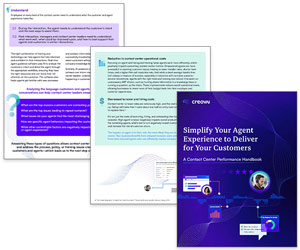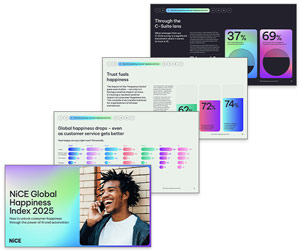Gerry Brown explains what customer satisfaction really is and how you can achieve it.
Measuring customer satisfaction is often as unreliable as election polls. The gap between what people say they will do and their actual actions can have many politicians and business people eating their hats or even their kilts.
Mick Jagger’s plaintive cry from 50 years ago – I can’t get no satisfaction – still rings true for many of us when we have a bad customer service experience. While what he wanted to meet his needs may not come up too often in a customer experience discussion (maybe the white shirt), I’m sure we have all felt equally frustrated when we don’t get satisfaction, however we measure what that means, from the companies we do business with.
Aiming for rock star customer service every time is fatiguing
I think that part of the problem is the term customer satisfaction and the word that makes up half of that expression. It’s become very popular with the Sultans of Semantics who dissect customer experience and the terminology used to question whether or not we should get more than satisfaction. That just being satisfied isn’t enough and that we need to be surprised, delighted, thrilled, enthralled or otherwise brought to a state of near ecstasy in all of our customer experiences.

A number of pundits, often our American cousins, tell us we should settle for nothing less than legendary, rock star, magical, memorable service. And I don’t totally disagree with them as I really do like to get delighted every now and then. But while it’s an honourable and bold objective, trying to do that with every customer every time in every situation is positively fatiguing for all concerned.
But it is important to know what delights or dissatisfies customers and being able to recognise when you need to step up. If employees are encouraged to look for these opportunities and empowered to act on them when they appear, customers will be delighted at the right time, for the right reason. These exceptional service experiences will provide customers with positive good news stories about the company, and eventually the company will build a reputation that stands it apart from the competition. When it comes to delight, a little goes a long way and even making it easy and effortless has its rewards.
The customer service bar is set incredibly low
The reason for that is that the customer service bar is set incredibly low, especially for those services we use every day, trains, planes, fuel, energy, telecoms, banks, where simply delivering the expected service seems a step too far. We need look no further than a May 2015 Which? survey on customer service in call centres that showed how truly awful many of these companies are in terms of meeting even our basic expectations and leaving us far from satisfied.
But perhaps it’s worth having a quick look at a dictionary definition of satisfaction:
- Giving or enjoying a state of comfort
- Fulfilment of one’s wishes, expectations, or needs, or the pleasure derived from this
- The payment of a debt or fulfilment of an obligation or claim
Here are some words and phrases that are also synonymous with satisfaction.
Delight, peace of mind, serenity, pleasure, gratification, fulfilment, happiness, sense of well-being, joy. None could argue that these aren’t worthy and honourable objectives for any business. Although I’m guessing that none of these were used in describing the worst performing companies in the Which? survey.
Most service interactions are and should be routine
We all interact with a wide range of businesses dozens of times a week and most of those service interactions are and should be routine. Customers want customer service people to be efficient, tuned into our specific situation, helpful and pleasant, but the service interaction itself should not become the centre of attention. It is the result that matters.

And satisfaction is no guarantee of loyalty. A recent survey by Accenture showed that of the 8,000 home and car insurance customers surveyed in 14 countries, 86% said that they were satisfied with their claims experience in the past two years but 41% of those admitted that they are still likely or very likely to change insurers in the next 12 months.
We have a number of ways to measure satisfaction that can often seem in conflict with each other. Should it be CSAT, NPS or CES, total spend? They all measure different things, in different ways, and often, at different times. But when used in combination, with some underlying data as to the “why”, “when“ and “where”, they can be very powerful and informative in business management.
There are four key ways that are critical to success
But for me, there are four key ways that, regardless of your unit of measurement or the business that you’re in, are critical to success.
1. Empower employees – Make it personal and let them be themselves
This is an often overused phrase, and many times there are large perceptual gaps, big enough to drive a truck through, between a company’s ambitions and employees’ reality. But the concept is critical to success. This is all about giving employees permission to engage with customers on an emotional and personal level and letting them be themselves.
Most of us naturally want to help others and come pre-wired with an attitude and a caring side that is ideally suited to achieving that objective. We all fundamentally know what’s right and wrong and how we should treat others. For those of us in the UK who have been thrilled by the TV series Poldark recently, Jud Paynter’s immortal and eloquent words; “T’int right, t’int fair, t’int proper”, are accurate and inspirational, even if not normally found in customer service training manuals. But often organisations want to actively discourage any personal feelings or emotions from creeping into their employees’ actions, and they expect their employees to put these in a drawer marked “not to be opened during business hours.”

Yes, there should some guidelines and you don’t want them giving away the store. But the customer service agent owns “the moment,” and has the greatest impact on the customer experience in the initial interactions. The best companies enhance their customer engagement by encouraging employees to build on their natural feelings, emotions and attitudes and do the right thing – for the customer.
These organisations put the spotlight on these talents and believe that if you can unleash imagination, encourage innovation and build trust based on simple human behaviour and principles, then people will come together in a common purpose – and customers, employees and companies all win. This puts the responsibility for great customer experience back where it belongs; in the hands, and voice, of the people who deliver the service. Let them have the knowledge needed, the trust and freedom to use it wisely, and set them free to execute.
In Oscar Wilde’s An Ideal Husband Lady Markby says “as a rule everyone turns out to be someone else.” But in the world of customer service it’s best to let them be themselves – everyone else is already taken!
2. Enable the organisation – Where agility, flexibility & adaptability trump dumb rules
Even if an employee is totally empowered, enablement means they have the right tools, data, knowledge and organisational incentives to overcome procedural roadblocks and dumb company rules to really execute against your customer engagement strategy. It’s about creating an environment in which employees are continuously provided the right information at the right time and the encouragement to take affirmative action and not be constricted by policies and procedures that worked fine in the 1950s but aren’t fit for purpose now.
Customer-obsessed companies realise that customer service and the customer experience are not based on all customers being equal. They align their processes, empower their staff and have the enabling technology to make sure that each customer interaction is relevant, personalised and satisfying.
And the key to this is consistency. Just having these things in place is not enough; they’ve got to be used every day with every customer and available across every channel. Often an employee is more than willing and able to address an issue but doesn’t have access to the information necessary to do that. Many businesses mired in a morass of legacy treacle and multiple, disparate databases, have zero real-time visibility into basic information such as contact history and current and past purchases. Failing to equip agents with the correct tools and latest technologies results in the loss of insight into the basic information needed to provide proper customer service and a resulting drop in customer satisfaction, if not business.
3. Engage and communicate with customers – Right message, right time, right people, right result
In an increasingly commoditised world, organisations must focus on how they can differentiate themselves. This may be how they engage and connect with customers on an individual, personal basis and is often the missing piece in the engagement puzzle. One example that I’m sure we’re all familiar with is when an online shopper has a problem at check-out. According to the Baymard Institute, the abandonment rate currently stands at 68%. In other words, if 1,000 people visit a site and add at least one item to their shopping baskets, 680 will bail out while only 320 will enter their card details and press the buy button. That represents a huge amount of lost business.

Being able to alert managers and agents when baskets are abandoned at key stages of the journey is vital. Notably at checkout, where managers and sales agents can then look more closely at the journey leading up to a basket being abandoned and select higher-value customers to contact who have provided details – such as phone numbers or email addresses – before subsequently bailing out.
A recent survey of 75 UK retail businesses showed that only one of them, yes only one of them, contacted the customer in real time, either by phone, SMS or email to find out why they had abandoned. Identifying a customer having an issue in real time and conducting proactive support would greatly improve both the transactional, touchpoint customer experience and contribute to the full customer journey. Other studies show that when these customers are contacted promptly, this is often enough to recover the basket and win the business, and significantly improve customer satisfaction.
Another way that businesses don’t make the most of customer engagement is with surveys. We’re probably all suffering survey fatigue and when asked to complete another, whether online or via an IVR, we usually decline. I think the reason for this is simple. When was the last time that a company thanked you for taking part in a survey and shared the results with you? That’s what I thought. It was a rhetorical question. But imagine if they sent you an email thanking you for taking the time to complete their survey and finished with “As a result of the feedback that you and other customers have provided, these are the changes we’ve made to improve your experiences with us.”
4. Embed a culture of excellence – Defined by the customer, refined by the people
You must understand what excellence means and what great looks like. David Hume, a Scottish philosopher, said in 1757 that “Beauty is no quality in things themselves, it exists merely in the mind which contemplates them.” This is equally true of excellence in any endeavour. The best and in fact the only arbiters of excellence are customers. They will define what great service is, and what satisfaction means to them, and this will be the ongoing barometer of excellence in your business. So creating an environment where listening, hearing and acting becomes second nature is critical to achieving consistent high levels of customer satisfaction.
But that’s only half the battle. To truly be best in class, and to develop and embed this culture of excellence, organisations must effectively leverage their talent, technology, and metrics to proactively anticipate and fulfil customer needs and expectations.
In a recent article entitled “Defining the ‘human touch’ in the customer relationship”, Steven Van Belleghem looked at three areas in which humans excel. This is their ability to add empathy, creativity and passion to any interaction. He notes that “Creativity and innovation are uniquely human characteristics. It is smart for companies to allow human creativity to blossom in all phases of the customer relationship. You must allow all your staff to think creatively about improvements that can benefit the customer.”
This is where the previous 3 elements really come together and complete the story.

Gerry Brown
Employees who are trusted , treated well and empowered, have the tools and knowledge to succeed and the ability to use them wisely and are held accountable, but have authority, can really delight customers and make each experience, regardless of complexity, a memorable one that will have customers coming back for more.
And even if customers can’t always get what they want, they’ll certainly get what they need!
With thanks to Gerry Brown, The Customer Lifeguard
Author: Gerry Brown
Reviewed by: Jonty Pearce
Published On: 17th Jun 2015 - Last modified: 15th Aug 2025
Read more about - Customer Service Strategy, Customer Satisfaction (CSAT), Customer Service, Editor's Picks, Empowering Agents, Gerry Brown, Handling Customers, Service Strategy





















Thanks for the mention, Gerry.
Steven Van Belleghem